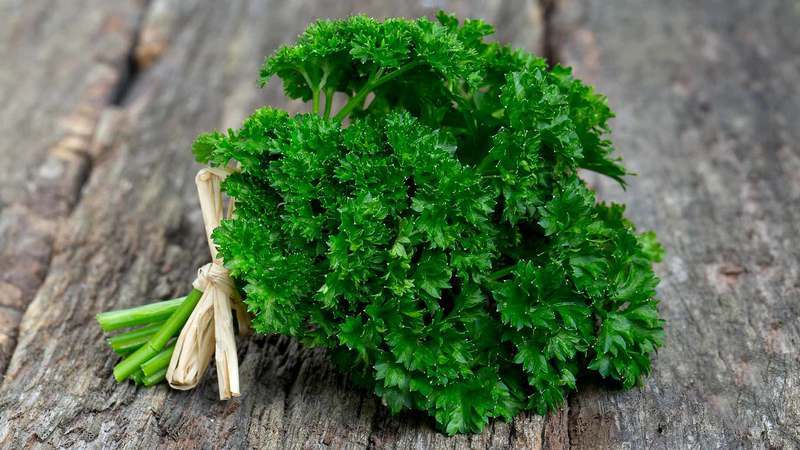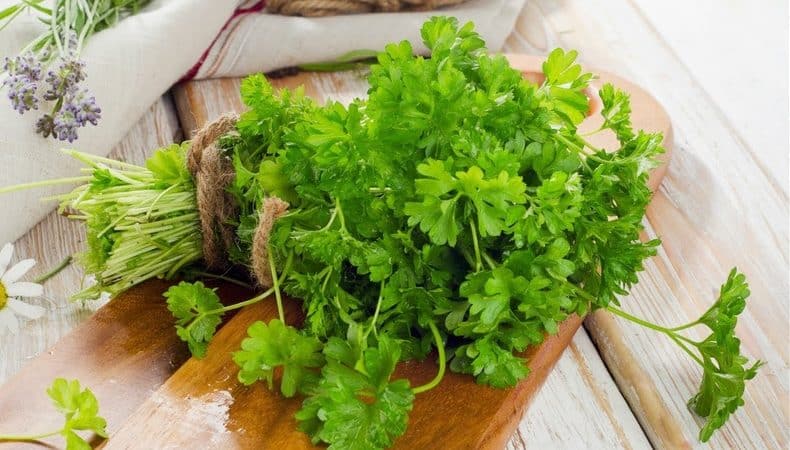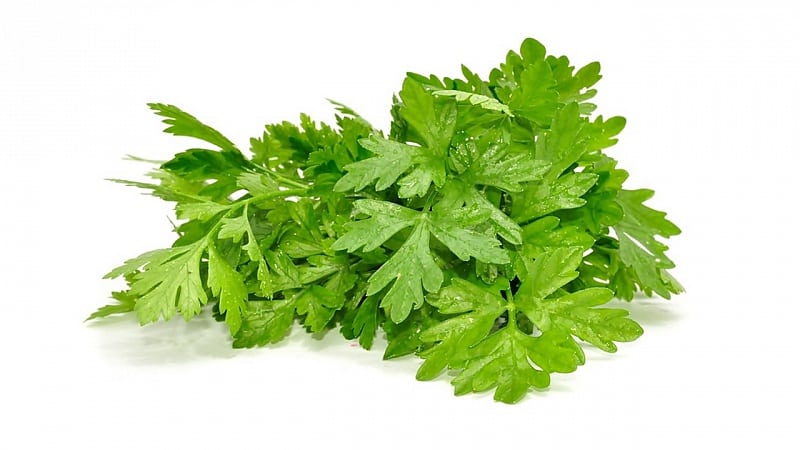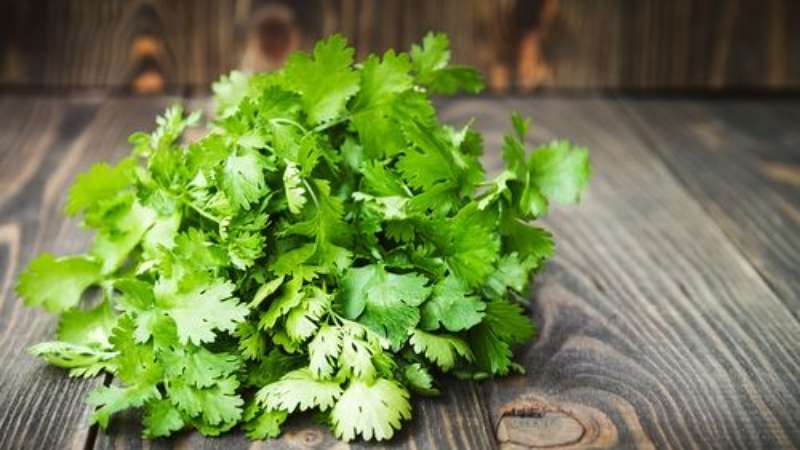Medicinal properties of parsley and contraindications for use
Parsley grows even on rocky soils, which is very convenient for it. growing. In cooking, there are 2 main types of plants - curly and Italian. The first has wrinkled leaves with a bitter taste, the second has flat leaves with a pronounced aroma.
We will talk about the chemical composition of parsley, its benefits and medicinal properties, harm to health and contraindications in this article.
Composition of parsley

If the greens were grown without the addition of unnecessary chemical fertilizers and growth accelerators, they will be very useful.
100 g of product contains the following vitamins:
- K - 658% of the daily value;
- C - 431%;
- beta-carotene - 111%;
- B1 - 7%;
- B2 - 17%;
- B6 - 10%;
- B9 - 29%;
- E - 18%.
Parsley leaves and stems are rich in macronutrients such as:
- silicon - 50%;
- potassium - 24%;
- calcium - 20%;
- magnesium - 16%;
- phosphorus - 10%;
- sodium - 9%;
- chlorine - 7%.
Key microelements in greens:
- manganese - 155%;
- boron - 107%;
- vanadium - 61%;
- iron - 48%;
- nickel - 43%;
- rubidium - 42%;
- cobalt - 41%;
- lithium - 21%;
- iodine - 17%;
- chromium - 16%;
- copper - 12%;
- zinc - 11%.
The roots have a less rich composition, but they are also good for health. They contain:
- vitamins K, C, group B;
- potassium, silicon, phosphorus, calcium, magnesium;
- boron, vanadium, manganese, copper, rubidium, zinc, cobalt.
Calorie content and BZHU
The calorie content of the above-ground part of parsley is low - 36 kcal per 100 g. At the roots the value is higher - 51 kcal.
The nutritional value of the plant per 100 g is presented in the table:
| Substances | Greenery | Root |
| Squirrels | 3.2-4.5 g - 5% | 1.5 g - 3% |
| Fats | 1.2 g - 1% | 0.6 g - 1% |
| Carbohydrates | 4.6-10.2 g - 2% | 13.3 g - 5% |
The glycemic index of the green part of parsley is 5 units, the roots - 10. This is a low figure, for example, in comparison with dill (15), radishes (15), and cucumber (20). Greens are suitable for people with diabetes.
The polysaccharide inulin contained in parsley normalizes blood glucose levels.
Is it suitable for weight loss
Parsley is a low-calorie plant, so it is well suited for those who are watching their weight or want to reduce it. The plant has a diuretic effect: decoctions of leaves, stems, seeds and roots flush excess water from the body. This helps relieve swelling and weight regulation.
Important! Decoctions from diuretic plants should not be abused, since valuable substances are excreted along with urine. The product is used systematically, otherwise excess liquid will accumulate again.
Thanks to dietary fiber, appetite is suppressed, which is why daily calorie intake is reduced. The body is cleansed of cholesterol and harmful substances. Fat metabolism is stimulated in the structure of subcutaneous tissues, which helps get rid of cellulite. Parsley infusions calm the nervous system, so even the most strict diet does not disturb the psycho-emotional state.
Infusions, decoctions, and teas are made from the plant. Leaves and stems are added to salads and soups. Parsley is eaten dry, fresh or frozen.
Beneficial properties of parsley
The level of vitamin C in greens is higher than in lemon and other citrus fruits. The plant strengthens the immune system and has an antioxidant effect.

Some of the beneficial effects of parsley are:
- decreased blood sugar levels;
- beneficial effect on the digestive system;
- assistance in removing kidney stones;
- prevention of cardiovascular diseases;
- antiseptic properties;
- normalization of hormonal levels;
- eliminating bad breath, healing wounds and eliminating inflammation;
- toning and cleansing of the skin;
- reduction of swelling and pain from insect bites.
Parsley is useful for people whose lifestyle or profession is closely related to high mental and physical stress and systematic lack of sleep. This plant has a beneficial effect on oxygen balance and stabilizes brain function.
For women
Women Parsley is useful in that during the menstrual cycle it relieves muscle spasms and eliminates painful symptoms. Thanks to folic acid, reproductive function is normalized and the correct formation of the fetus is ensured during pregnancy.
Important! The plant is added to the diet of a pregnant woman in moderation, as it accelerates blood circulation in the pelvic area and increases the risk of premature birth or fetal rejection.
To prevent, treat or eliminate the symptoms of cystitis, use decoctions of parsley leaves and stems. It is important to remember that the plant does not replace medications and is used as an addition to primary therapy.
For men
Parsley has a positive effect on the male reproductive system. The bioflavonoid apigenin contained in the plant reduces the amount of female hormones, increases testosterone synthesis, has powerful antioxidant properties, and is effective in the fight against cancer and prostate diseases.
Daily consumption of the plant reduces the risk of cardiovascular diseases. Parsley removes not only toxins, but also ethyl alcohol, which is especially important after busy feasts.
For children
The biochemical composition of parsley retains its benefits even after short-term heat treatment. Thus, thanks to essential oils, resistance to viral diseases increases. The high content of vitamins A and E promotes accelerated healing of damaged tissues.
Iron, chlorophyll, folic acid improve blood condition, which has a positive effect on the child’s body with anemia. Potassium and magnesium lower blood pressure, normalize heart function, and maintain muscle tone.
In adolescence, this plant cleanses the skin - helps get rid of acne, blackheads, and freckles. It is used as a mask or simply added to the diet.

What parts of the plant are used?
Depending on the recipe, you use roots, stems, leaves or seeds. They are soaked or boiled.
The plant brings the greatest benefit to the human body when it is fresh. However, in winter it is difficult to grow it in sufficient quantities indoors, so the greens are preserved until the next season in any of the following ways: canning, salting, drying, freezing (both chopped and in pieces of ice).
Features of application and recipes
All parts of parsley are used in medicine and cosmetology, as well as in cooking, and even in everyday life. For this purpose, any varieties are used, but the most popular are Beads, Titan, Rialto.
For weight loss
The plant is used comprehensively for weight loss, in combination with proper nutrition, a healthy lifestyle and physical activity. There are many recipes with parsley.
To choose the right one, focus on your preferences:
- To prepare a decoction, pour 50 g of chopped herbs into 1 liter of hot water, bring to a boil and cook for 5 minutes. The product is cooled and filtered. Take 200 ml 15 minutes before meals.
- To make an infusion, 1/2 tsp. seeds are poured into a glass and filled with boiling water to the brim. Keep covered for 10 minutes. Drink 180 ml twice a day at any time.
Chopped fresh or frozen herbs are useful for seasoning puree soup.
In cosmetology

Parsley contains elements important for the skin:
- carotene protects the skin from exposure to sunlight, helps it remain elastic and smooth, and maintains water balance;
- Vitamin PP saturates the skin with oxygen and improves blood circulation;
- vitamin B2 is involved in the renewal of epidermal cells.
To make a nourishing mask, mix 30 g of chopped herbs and 100 g of sour cream and apply to the face for 15–20 minutes. Afterwards, wash off with cool water without soap or cosmetics.
In folk medicine
The root of the plant is used in folk medicine to prevent cardiovascular diseases. To prepare a decoction, pour 40 g of finely chopped root into 1/4 tbsp. boiling water, leave covered for 12 hours, filter and add 10 g of linden honey. Take 15 g orally 4 times a day half an hour before meals.
At home
Sometimes parsley is used in non-standard ways, for example, the juice is used to color Easter eggs greenish.
In the garden, the plant helps get rid of aphids because it releases enzymes that repel insects. When combined with other components, it is used as a fertilizer.
Possible harm and contraindications
The main contraindications are allergies to the product, acute stage of diseases of the genitourinary and digestive systems.
If consumed excessively, greens can lead to headaches, nausea, cramps, and sudden weight loss. The daily norm for a person is no more than 100 g of the plant.
Conclusion
Eating parsley within normal limits will relieve symptoms of diseases of the genitourinary system, strengthen the heart and blood vessels, normalize the psycho-emotional state, and improve appearance. Both adults and children benefit from not only the leaves and stems of the plant, but also the roots and seeds.